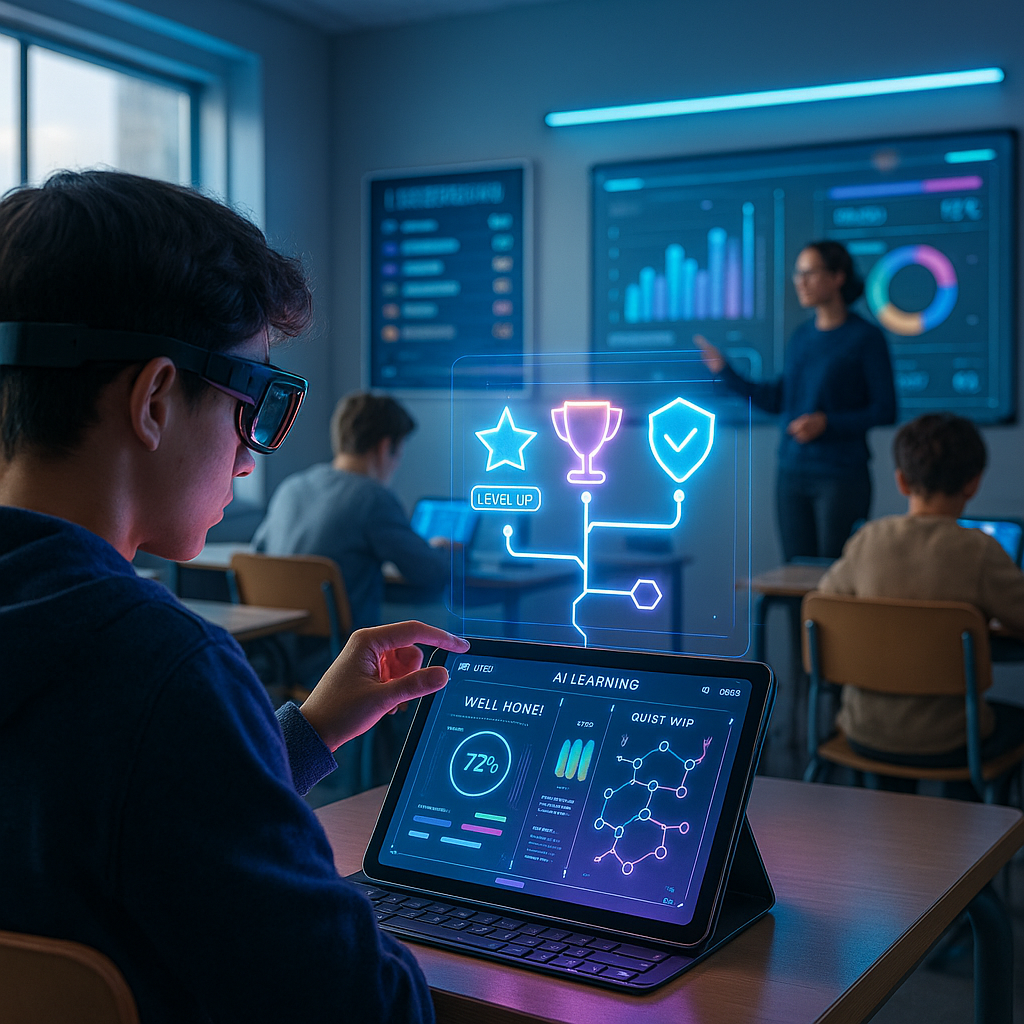Key Takeaways
- AI tailors learning to the individual at scale. Adaptive learning AI harnesses real-time student performance data to continuously adjust curriculum content, providing deeply personalized education that aligns with diverse learning styles and paces across large student populations.
- Gamification transforms engagement from passive to active. By integrating rewards, challenges, and immediate feedback, AI-powered gamification cultivates interactive experiences that dramatically increase student motivation and participation compared to traditional educational models.
- Measurable engagement metrics prove gamification’s impact. Advanced adaptive platforms rigorously track analytics such as time-on-task, progression rates, and completion statistics, offering clear, data-driven evidence of gamification’s role in sustaining learner involvement.
- Personalization drives better learning outcomes. Context-aware adaptation through machine learning not only boosts engagement but also translates into improved mastery and retention. Adaptive systems meticulously track academic progress, providing real-time documentation of each learner’s development.
- Real-time feedback and dynamic pathways accelerate mastery. Learners benefit from instant, individualized feedback and are smoothly guided along optimal educational trajectories, closing skill gaps more rapidly than possible with static, uniform instruction.
- AI empowers educators with actionable insights. Teachers and administrators gain comprehensive visibility into student progress through intuitive dashboards, enabling timely interventions and targeted support that maximize engagement and achievement.
- Effective implementation requires thoughtful integration. Success with AI-driven gamification in education depends on alignment with curricular goals, adherence to robust data privacy standards, and ongoing professional development for instructors.
By unpacking the technological and human-centered elements, the following article illustrates how adaptive learning AI and gamification collaboratively personalize education in practical, measurable ways. The resulting synergy is already reshaping classrooms and redefining what student engagement and academic outcomes look like. Let’s dive into this convergence and its transformative effects on the future of learning.
Introduction
Even the most forward-thinking educators often underestimate the sweeping changes adaptive learning AI and gamification bring to modern classrooms. Far beyond the limitations of static e-learning modules, today’s intelligent platforms meticulously analyze each student’s learning style, strengths, and challenges in real time. They dynamically shift content, present tailored challenges, and provide instant feedback, ensuring that motivation stays high and learning stays on course.
What truly sets these technologies apart is not just their automation, but their capacity to transform passive information delivery into vibrant, personalized learning journeys. These journeys are measured not in terms of mere completions but in actual mastery and enduring motivation. For education leaders pursuing evidence-based innovations with proven impact, understanding the mechanisms and real-world benefits of adaptive learning AI is now mission-critical.
In the following exploration, we reveal how the worlds of adaptive AI and gamified learning intertwine (melding machine intelligence, actionable analytics, and learner-centric design) to shape the next era of education.
Stay Sharp. Stay Ahead.
Join our Telegram Channel for exclusive content, real insights,
engage with us and other members and get access to
insider updates, early news and top insights.
 Join the Channel
Join the Channel
The Fundamentals of Adaptive Learning AI in Education
The introduction of adaptive learning AI marks a decisive departure from one-size-fits-all approaches, ushering in dynamic pathways uniquely suited to each learner. Rather than offering generic instruction, these systems leverage advanced algorithms that respond intelligently to every student’s ongoing performance, engagement levels, and individual needs.
Core Components of Adaptive Learning Systems
Modern adaptive learning platforms rely on three foundational components:
- Knowledge Space Theory (KST) Engine: This component maps the relationships between concepts and their prerequisites, creating an adaptive, dynamic topology that guides student progression logically through content.
- Learner Model: Acting as a detailed profile, this model tracks each individual’s progress, identifies misconceptions, and monitors learning velocities across multiple subjects. It evolves continuously, reflecting new insights with every student action.
- Pedagogical Rules Engine: This governs the choreography of content delivery, tailoring instructional tactics in real time based on ongoing performance analytics.
By integrating natural language processing and machine learning, such systems interpret student responses with fine-tuned precision. For example, Carnegie Learning’s MATHia platform analyzed over 40,000 data points per student hour, resulting in a measurable 12 percent increase in mathematics proficiency.
Personalization Mechanisms
The hallmark of adaptive platforms lies in their multi-dimensional personalization:
- Pace Modulation: Content is delivered at a pace that adapts to individual comprehension, preventing frustration from overwhelming difficulty and boredom from excessive repetition.
- Difficulty Scaling: The level of challenge is dynamically adjusted to maintain optimal engagement, encouraging growth without becoming discouraging.
- Learning Style Adaptation: Content is presented in various modalities (visual, auditory, kinesthetic) adapting to the approach each learner responds to best.
At Arizona State University, implementing intelligent content sequencing and real-time intervention triggers resulted in an 18 percent reduction in course dropout rates, underscoring the tangible benefits of adaptive personalization.
Adaptive learning AI’s flexible architecture is proving invaluable in a wide array of disciplines. From healthcare training (customizing clinical simulations for medical students) to professional development in corporate settings (matching learning modules to employee skill gaps), its reach just keeps growing.
Gamification as the Key Driver of Engagement in Adaptive Education Platforms
Transitioning from the foundation of adaptive learning, gamification injects an entirely new level of motivation and engagement. Rather than treating education as a routine task, these platforms, when powered by AI, weave game mechanics into the very fabric of the student experience, converting learning objectives into immersive, rewarding adventures.
Core Gaming Elements in Educational Contexts
Adaptive platforms now feature advanced game design elements that drive persistent engagement:
- Achievement Systems: Progression is tracked with badges, level-ups, and earned privileges, incentivizing continuous effort and recognizing mastery milestones.
- Competitive Elements: Leaderboards, peer challenges, and collaborative competitions are tailored to account for diverse abilities, ensuring that competition inspires rather than discourages.
- Narrative Integration: Educational content is wrapped in immersive storytelling frameworks, transforming abstract concepts into relatable, memorable scenarios.
Research at the University of Michigan has shown that gamified adaptive learning environments boost student engagement by 47 percent relative to traditional digital methods, pointing to the profound motivational force of layered game mechanics.
AI-Driven Dynamic Difficulty Adjustment
Here, artificial intelligence acts as the orchestrator, optimizing every aspect of the learning “game”:
- Flow State Optimization: Algorithms strive to keep learners in the “zone,” where challenges are neither too hard nor too easy, sustaining attention and motivation.
- Failure Prediction: Early-warning analytics anticipate when students are about to struggle, triggering proactive support or tailored hints before disengagement sets in.
- Success Pattern Recognition: AI identifies learning strategies that work for each individual and amplifies them, personalizing the “path to victory” for every learner.
Real-world applications now extend far beyond the classroom. In healthcare, simulations use gamified AI to sharpen diagnostic and procedural skills; in finance, adaptive platforms gamify regulatory training, turning compliance into engaging challenges; in marketing education, adaptive gamification helps learners master consumer behavior analysis efficiently.
Measuring Engagement and Outcomes in AI-Enhanced Learning
To ensure innovation translates into concrete results, adaptive learning systems must offer robust methods to measure both engagement and academic progress. These platforms set new standards for educational analytics, capturing nuances missed by traditional tests.
Key Performance Indicators
Sophisticated adaptive systems evaluate engagement and learning efficacy through multiple dimensions, such as:
- Time-on-Task Metrics: This measures not just raw time spent, but the quality and depth of student engagement.
- Learning Velocity: The speed at which learners acquire new competencies across varied domains.
- Persistence Patterns: How students respond to failure, recover from mistakes, and persist through challenges.
A series of studies by Stanford’s Learning Analytics Lab found that well-implemented adaptive systems improved retention rates by 23 percent and reduced time-to-mastery by 30 percent, highlighting the real-world gains in knowledge and skills.
Advanced Analytics Frameworks
These platforms go significantly beyond simple reporting:
- Multi-modal Learning Analytics: Platforms integrate data from clickstreams, device interactions, facial recognition, and even natural language assessments to form a holistic view of engagement.
- Predictive Performance Modeling: AI anticipates individual outcomes, alerting educators to possible learning roadblocks before they become insurmountable.
- Engagement Pattern Recognition: Platforms identify which learning sequences or module combinations generate the strongest outcomes.
This level of analytics finds applications in diverse sectors. From evaluating patient outcomes in adaptive medical training to optimizing learning milestones in workforce development and even improving outcomes in environmental education by personalizing environmental science modules to student interests and progress.
Stay Sharp. Stay Ahead.
Join our Telegram Channel for exclusive content, real insights,
engage with us and other members and get access to
insider updates, early news and top insights.
 Join the Channel
Join the Channel
Implementation Strategies for AI-Driven Gamification in Education
Integrating these groundbreaking systems into educational institutions is a complex endeavor that requires thoughtful planning and agile management.
Technical Infrastructure Requirements
To unlock the full power of adaptive, gamified learning, schools and organizations must build on solid technical foundations:
- Scalable Cloud Architecture: Enables real-time data processing and analysis across large cohorts without latency or data loss.
- Integration Frameworks: API-driven connections ensure seamless operation with existing learning management systems and databases.
- Data Security Protocols: Stringent, FERPA-compliant measures safeguard sensitive learner data, protecting privacy and trust.
Change Management Approach
Effective adoption depends on navigating institutional and human factors:
- Stakeholder Analysis: Successful implementation begins by identifying and engaging influential leaders, educators, and potential skeptics, building buy-in early.
- Phased Rollout: Piloting adaptive gamification in select courses or grades allows for iterative improvement before a wider launch, minimizing risk and maximizing learning.
- Continuous Feedback Loops: Regular assessment and adjustment, based on input from teachers, students, and parents, ensure the system evolves to meet real-world needs.
Cross-industry collaborations (such as partnerships between edtech startups, school districts, and healthcare institutions) further highlight the importance of robust, adaptive infrastructure and agile change management.
Actionable Insights for Schools and Educators
For educators and administrators aiming to maximize the benefits of adaptive learning systems, strategic integration and ongoing optimization are paramount.
Best Practices for Integration
Critical success hinges on:
- Teacher Training Programs: Comprehensive professional development equips instructors to leverage adaptive insights, design effective interventions, and guide students through dynamic content.
- Student Onboarding: Structured, engaging introductions help learners understand platform features and cultivate a growth mindset in navigating personalized paths.
- Parent Communication: Clear, regular updates about student progress and system benefits foster trust and encourage family support for new learning methods.
Optimization Strategies
Continuous improvement is driven by:
- Regular Data Analysis: Schools should monitor engagement metrics and outcomes monthly, using insights to refine strategy.
- Feature Utilization Assessment: Identifying which adaptive and gamification features produce the best results enables targeted investments and enhancements.
- Community Feedback Integration: Collecting and acting on feedback from students and teachers ensures the system remains responsive and effective.
These strategies apply equally well in higher education, K-12, corporate settings, and professional training, affirming adaptive learning’s universal relevance.
Conclusion
Adaptive learning AI is fundamentally redefining the essence of education in the digital age. By uniting real-time analytics, dynamic content personalization, and gamified engagement, these platforms demolish the limitations of conventional instruction. They open the door to truly individualized educational journeys. As students are guided by narrative-rich challenges and instant feedback, they not only attain greater mastery and retention but also cultivate lasting curiosity and resilience.
Yet, the journey to successful integration is not an automatic leap. It requires strategic alignment, committed professional growth, and an adaptive culture receptive to ongoing experimentation. The most forward-thinking schools, healthcare providers, and businesses will be those that nurture adaptive mindsets. They will prepare learners not only to master content today, but to thrive in a future where knowledge, technology, and challenge co-evolve.
In a world increasingly shaped by intelligent technologies, those who harness the synergy of adaptive AI and gamification will lead the way, setting new standards for educational transformation and lifelong learning. The true challenge ahead is not whether to embrace these advancements but to determine how boldly and thoughtfully we will wield them to unlock human potential.
intelligent feedback systems are a related pillar topic, as modern adaptive education relies on real-time feedback loops to drive continuous learning and brain adaptation.
For inclusive education contexts—such as supporting neurodivergent students—AI-powered adaptive platforms share core personalization mechanisms with AI education tools for neurodivergent learners, highlighting the universal reach of these innovations.
On a philosophical level, the convergence of adaptive learning and digital technology also intersects with debates on the origins of intelligence—inviting us to consider whether adaptive AI merely simulates human thought, or reveals fundamental cognitive structures shared by humans and machines.
Finally, as these systems become deeply embedded in organizational and personal knowledge environments, their evolution aligns with the rapidly advancing field of AI personal knowledge management tools, which are fundamentally transforming how learners, educators, and professionals manage and build upon digital knowledge.





Leave a Reply